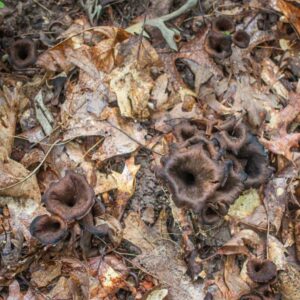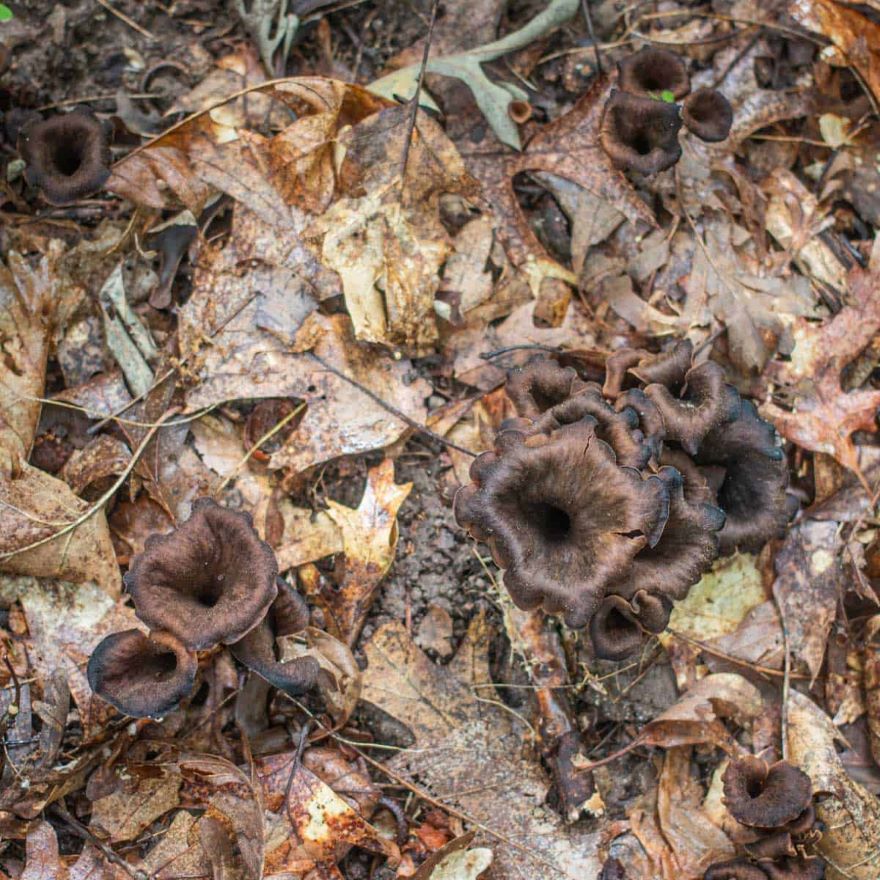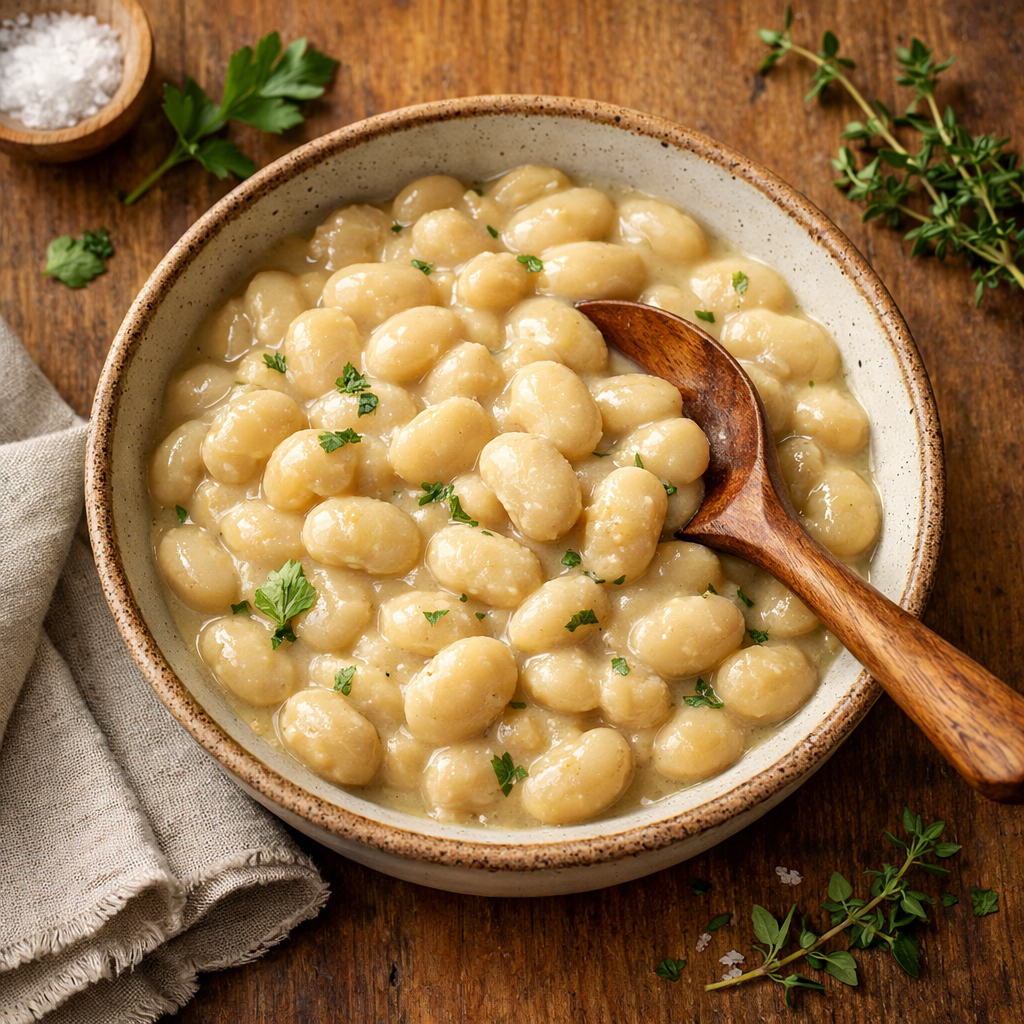Black Trumpet mushrooms, scientifically known as Craterellus cornucopioides, are a fascinating variety of edible wild mushrooms. Known as the “horn of plenty,” these fungi are prized for their appearance, flavor, and culinary versatility. Foraging for these mushrooms in forests is a rewarding experience for novice and experienced hunters.

Despite their elusive nature, the excitement of discovering these dark, funnel-shaped mushrooms is unmatched. Black Trumpet mushrooms enhance dishes and offers numerous health benefits. Learn about these unique fungi, from foraging to culinary uses, and add excitement to your cooking skills.
Key Takeaways
- Black Trumpet mushrooms offer a unique culinary experience and are known for their strong flavor.
- Foraging for these mushrooms can be a rewarding outdoor activity for both beginners and experts.
- Learning more about Black Trumpet mushrooms may inspire you to explore other wild mushrooms and their numerous benefits.
Foraging Black Trumpet Mushrooms
Identifying Characteristics
When I forage for Black Trumpet Mushrooms (Craterellus cornucopioides), I look for their unique trumpet-like shape. They’re usually dark gray to black in color and can be easily distinguished by their lack of gills. Their cap is fused with the stem and forms a deep hollow cup. These mushrooms have a smoky, rich flavor and a pleasant, fruity aroma, which makes them a favorite among foragers.
Here are some key characteristics:
- Color: Dark gray to black
- Shape: Trumpet-like or funnel-shaped
- Texture: Smooth
- Smell: Fruity and earthy
Best Foraging Practices
I’ve developed some best practices for foraging these gourmet mushrooms. One important tip is to carry a mesh bag or basket to help disperse spores as I walk through the woods, promoting their growth for future years. I also use a small knife or scissors to cut the mushrooms at the base of the stem, being careful not to pull them out entirely to avoid disturbing their mycelium. Before leaving the foraging area, I ensure that it is left in the same condition as when I arrived, to preserve the natural habitat.
Seasons and Habitats
Timing is crucial in foraging for Black Trumpet Mushrooms. They prefer to grow in late summer and fall, and can often be found east of the Rockies, with a mycorrhizal relationship with oak trees. It’s essential to be aware of the seasons and habitats suitable for these mushrooms when planning my foraging trips.
To summarize, here’s a quick reference table for these delicious mushrooms:
| Property | Description |
|---|---|
| Season | Late summer and fall |
| Habitat | Deciduous forests, near oaks |
Health Benefits of Black Trumpet Mushrooms
Nutritional Value
In my experience, black trumpet mushrooms are well known for their nutritional value. They are a good source of vitamins B12 and C, which are essential for maintaining overall health. Besides that, they contain antioxidants that help reduce inflammation in the body.
I have learned that it’s important to use good quality black trumpet mushrooms to fully take advantage of their nutritional benefits. When preparing them, I like to use them fresh or dried, and make sure they come from reliable sources.
Medicinal Properties
In addition to their nutritional value, black trumpet mushrooms are also known for their medicinal properties. For instance, their anti-inflammatory benefits are helpful for individuals suffering from arthritis and joint pain. Having tried them myself, I find that they can be a great addition to my diet, especially for combating inflammation.
Incorporating black trumpet mushrooms in various dishes, such as stir-fries or pasta, allows me to experience their health benefits while enjoying their unique flavor. In general, these mushrooms are not only delicious but also provide essential nutrients and medicinal properties that contribute to my overall well-being.
Culinary Uses and Recipes
Preparation Techniques
In my experience, one key aspect of cooking Black Trumpet Mushrooms is properly cleaning them. Due to their trumpet-like shape, dirt and debris can easily accumulate. I usually soak them in cool water for a few minutes, then gently rinse them under running water to remove any remaining particles. After cleaning, I pat them dry with a paper towel before cooking.
When it comes to cooking Black Trumpet Mushrooms, there are various methods to bring out their rich, earthy flavor and meaty texture. I find that sautéing is quite effective – simply heat some butter or oil in a pan and sauté the mushrooms until they release their natural moisture. Another option is to rehydrate dried mushrooms by soaking them in warm water for about 30 minutes.
Recipe Ideas
Black Trumpet Risotto: One of my favorite ways to incorporate Black Trumpet Mushrooms into a dish is by making a black trumpet risotto. Cook the risotto rice following the package instructions, sauté the mushrooms with garlic and onions, and then combine everything together. Add some white wine, grated parmesan, and fresh parsley to give it a vibrant and rich taste.
Mushroom and Leek Stir-Fry: Another recipe I enjoy is a mushroom and leek stir-fry. Cut the leeks into thin slices and sauté them with the mushrooms in a hot pan. Add some garlic, thyme, and white wine vinegar for an extra depth of flavor. This stir-fry can be served as a side dish or mixed with pasta for a hearty main course.
Black Trumpet Mushroom Soup: For a comforting meal, I turn to black trumpet mushroom soup. Start by sautéing onions, carrots, and celery in butter. Add the soaked and drained mushrooms, sauté for a few minutes, and then add vegetable or chicken stock. Simmer for about 20 minutes and finish the soup with a touch of cream, salt, and pepper.
I hope these recipe ideas will inspire you to experiment with Black Trumpet Mushrooms and enjoy their unique flavor profile in a variety of dishes. Happy cooking!
Preservation and Storage
Drying Methods
As a mushroom enthusiast, I find that drying is one of the best methods to preserve and store black trumpet mushrooms. I’ve discovered that there are various techniques you could use, depending on your preference. For instance, I occasionally use a food dehydrator to ensure even and quick drying. Another method I’ve tried is air drying them by stringing the mushrooms and hanging them in a well-ventilated area away from direct sunlight. Some people also prefer to use the oven drying method, just be careful not to use too high temperature, as it might affect the taste.
When drying black trumpets, I found it useful to lay them out on a tray in a single layer, making sure none are overlapping. This will help them dry evenly and give better results.
Freezing Techniques
I have also tried freezing black trumpet mushrooms, and I can assure that it’s an excellent short-term storage solution. Before freezing, I either blanch them briefly or sauté them in a light layer of oil, as this will help maintain their texture once thawed. Afterward, I lay the mushrooms on a parchment paper-lined baking sheet, ensuring there’s no overlap, and freeze them for a couple of hours. Once the mushrooms are frozen solid, I transfer them to a resealable freezer bag, squeezing out all the excess air. This method allows me to store them for a few weeks to a month in my freezer.
For longer-term storage, drying remains my top recommendation, as it helps preserve the mushrooms’ flavor and overall quality better than freezing. Don’t forget to store your dried black trumpets in an airtight container like a glass jar, and enjoy them in various culinary delights.
Environmental Considerations

Sustainable Foraging
When I go foraging for Black Trumpet Mushrooms, I always prioritize sustainability. To do this, I only harvest mushrooms when they have reached an adequate size, usually between 2-4 inches. Additionally, I make sure to leave some mushrooms behind, allowing them to complete their life cycle and maintain the local ecosystem. It’s important not to harvest old, moldy, or bug-ridden mushrooms.
Biodiversity Impact
I’ve learned that the Black Trumpet Mushroom has an impact on various aspects of our environment, including biodiversity. These mushrooms often grow in mossy areas, which are crucial for sustaining many other plant and animal species. By practicing sustainable foraging, we can preserve these vital habitats and contribute to biodiversity in the forest.
As a responsible mushroom forager, it’s fascinating that Black Trumpet Mushrooms can also play a role in scientific advancements, particularly in the realm of alternative energy. Researchers have developed a noble metal free photocatalyst using a Black Trumpet Mushroom-like ZnS incorporated with Cu3P, which can be used for superior photocatalytic H2 production. This is a great example of how fungi can be a resource for scientific and environmental advancements when we preserve and sustain their habitats.
Engaging With the Mushroom Community

As a mushroom enthusiast, I’ve discovered numerous resources and groups that have helped me learn more about Black Trumpet Mushrooms and connect with other foragers. In this section, I’ll share some of my favorite online resources and local foraging groups.
Online Resources
There are several websites and forums where I found valuable information about Black Trumpet Mushrooms, such as identification tips, foraging advice, and even recipes. Here are a few websites I highly recommend for anyone interested in these delicious fungi:
- Mushroom Appreciation: This site offers comprehensive guides on different mushrooms, including a detailed guide on identifying and foraging for Black Trumpet Mushrooms.
- GroCycle: Another fantastic site for learning about mushrooms and their natural history, GroCycle features The Complete Guide to Black Trumpet Mushrooms, which delves into the mythological origins of the mushroom’s name.
- Practical Self Reliance: A wonderful resource for beginner mushroom foragers, Practical Self Reliance offers a guide on identifying, harvesting, and cooking Black Trumpet Mushrooms.
Local Foraging Groups
Joining a local foraging group has been one of the most enjoyable experiences in my mushroom journey. Not only did I learn specific tips for finding Black Trumpet Mushrooms in my area, but I also met like-minded individuals who share a passion for foraging and wild foods.
- Mushroom Hunting Clubs: Many areas have local mushroom hunting clubs where members meet regularly for forays and help each other with identification. Look for a club near you by searching online or checking Facebook groups.
- Naturalist Organizations: Local nature centers, parks, and environmental organizations often host foraging workshops or guided walks. These events can be a fantastic way to learn about Black Trumpet Mushrooms and other edible plants in your area.
- Myco-Blitz: Some regions organize annual “Myco-Blitz” events, where groups of foragers join together to search for and document mushrooms in a specific area. Participating in a Myco-Blitz can be a fun way to engage with the mushroom community and learn about the local fungi.
By engaging with both online resources and local foraging groups, I can confidently say that my knowledge and skills in identifying and harvesting Black Trumpet Mushrooms have greatly improved. I hope you find these resources helpful and enjoy connecting with fellow mushroom enthusiasts.
Frequently Asked Questions

How can one correctly identify black trumpet mushrooms in the wild?
I have found that the best way to identify black trumpet mushrooms is by their unique “horn of plenty” shape and their dark color, which can range from black to dark gray or even dark brown. They don’t have the conventional cap-and-stem structure like many other mushrooms. It’s important to note that there aren’t any poisonous lookalikes, but it’s always best to consult a mushroom identification guide or an expert to ensure accurate identification. Mushroom Appreciation provides a helpful identification and foraging guide for black trumpet mushrooms.
What does the taste of black trumpet mushrooms compare to?
In my experience, black trumpet mushrooms have a distinct, rich flavor that is somewhat smoky and fruity. They are considered a gourmet edible and are highly prized by chefs. Their unique taste is sometimes compared to a combination of black olives and truffles.
What is the proper method for drying black trumpet mushrooms?
When I need to dry black trumpet mushrooms, I prefer to use a food dehydrator or set them out on a wire rack in a well-ventilated area, away from direct sunlight. It’s important to ensure that the mushrooms are completely dry before storing them in an airtight container to prevent mold growth.
In what type of habitats are black trumpet mushrooms typically found?
I’ve observed that black trumpet mushrooms commonly grow in hardwood forests, particularly near broad-leaved trees such as beech and oak. Although they don’t fruit directly on living or dead wood, they can often be found growing at the base of trees. They occur in the wild in North America, Europe, and Asia, as mentioned in this complete guide.
When is the typical foraging season for black trumpet mushrooms?
I have found that the best time to forage for black trumpet mushrooms is during the spring and summer months. However, the exact time can vary depending on the climate and location within their distribution range.
How should black trumpet mushrooms be cleaned before cooking?
When I clean black trumpet mushrooms before cooking, I use a gentle brush or my fingers to remove any dirt or debris. I avoid soaking them in water, as they can become mushy and lose their flavor. Instead, if necessary, I use a slightly damp cloth to clean the mushrooms and then pat them dry with a paper towel before cooking.

*We may earn a commission for purchases made using our links. Please see our disclosure to learn more.



